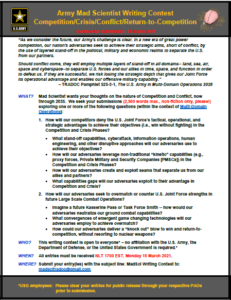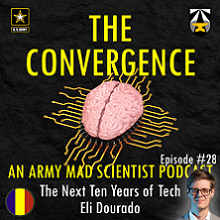[Editor’s Note: Mad Scientist is pleased to announce our latest episode of “The Convergence” podcast, featuring Eli Dourado, an economist and Senior Research Fellow at the Center for Growth and Opportunity at Utah State University — discussing technology opportunities in the next decade, the economic impact of shifting technology trends, and their impact on global security. Please note that this podcast and several of the embedded links below are best accessed via a non-DoD network due to network priorities for teleworking — Enjoy!]
[If the podcast dashboard is not rendering correctly for you, please click here to listen to the podcast]
 Eli Dourado is a senior research fellow at the Center for Growth and Opportunity (CGO) at Utah State University. He focuses on the hard technology and innovation needed to drive large increases in economic growth — speeding up infrastructure deployment, eliminating barriers to entrepreneurs operating in the physical world, and getting the most out of federal technology research programs. He has worked on a wide range of technology policy issues, including aviation, Internet governance, and cryptocurrency. His popular writing has appeared in The New York Times, The Wall Street Journal, The Washington Post, and Foreign Policy, among other outlets.
Eli Dourado is a senior research fellow at the Center for Growth and Opportunity (CGO) at Utah State University. He focuses on the hard technology and innovation needed to drive large increases in economic growth — speeding up infrastructure deployment, eliminating barriers to entrepreneurs operating in the physical world, and getting the most out of federal technology research programs. He has worked on a wide range of technology policy issues, including aviation, Internet governance, and cryptocurrency. His popular writing has appeared in The New York Times, The Wall Street Journal, The Washington Post, and Foreign Policy, among other outlets.
In today’s podcast, Mr. Dourado discusses technology opportunities in the next decade, the economic impact of shifting technology trends, and their impact on global security. The following bullet points highlight key insights from our interview with him:
-
-
- According to economic statistics, technological growth has stagnated since 2005. While some claim that the economy has fully matured and further growth will be limited, others argue that there is still room for growth, but U.S. culture and complacency has prevented further growth.
-
-
-
- In the next two decades, geothermal energy will have the biggest impact on economic development. Cheap, unlimited geothermal energy will enable the use of more expensive materials like silicon carbide by significantly reducing the cost to create them, produce energy without carbon emissions thus mitigating the effects of climate change, and reduce food security concerns via indoor growing models.
-
-
-
- The United States is now energy independent, which could incentivize a shift away from intervention in the Middle East. Conflict in the region could still significantly impact U.S. supply chains, given Asian reliance on Middle Eastern energy flows.
-
-
-
- While genetic enhancements are still decades away, brain computer interfaces (BCI) could allow soldiers to command technology at the speed of thought in the next ten years. Related bioethical concerns, while important, may also be limiting the growth of beneficial technologies.
-
-
-
- Decreasing launch costs are facilitating both commercial and governmental expansion in space. High resolution earth sensing technology could soon enable a “live Google Earth,” in which viewers could watch scenarios unfold in real time (e.g., Uyghur camps), impacting social movements.
-
-
-
- Augmented reality will be widely adopted by the middle of the decade. However, systems will still require the development of ‘contextual awareness’ to prevent overloading users with information. In a conflict situation, a balance will need to be found that does not distract soldiers, but provides critical information in real time.
-
-
-
- The U.S. military should use its procurement power to stimulate private investment in developing hard technologies. Currently, talent is pulled into app design and software development due to higher capacity financing.
-

Stay tuned to the Mad Scientist Laboratory for our next episode of “The Convergence,” featuring Mr. Shawn Steene (OSD Policy) and Mr. Michael Meier (HQDA OTJAG), discussing the ground truth on regulations and directives regarding lethal autonomy and what the future of autonomy for the force might mean in a complex threat environment on 18 February 2021!
If you enjoyed this post, check out the following:
Speed, Scope, and Convergence Trends.
Proclaimed Mad Scientist Dr. Jamie Canton‘s presentation on Convergence of Future Technology [watch via a non-DoD network] from the Mad Scientist Robotics, Artificial Intelligence, & Autonomy Conference at Georgia Tech Research Institute, Atlanta, Georgia, 7-8 March 2017.
Estimation of Technological Convergence by 2035, and the associated final report and briefing slides, by Lt Col Nicholas Delcour (USAF), Lt Col Louis Duncan (USAF), Mr. Stephen Frahm (DOS), CDR Patrick Lancaster (USN), and Lt Col Lance Vann (USAF), collectively known as the Army War College’s Mad Scientist Fellows of 2020, under the direction of Prof. Kristan Wheaton, U.S. Army War College.
Table of Future Technologies: A 360 Degree View Based on Anticipated Availability and the associated Table of Future Technologies, created by Richard Buchter.
Linking Brains to Machines, and Use of Neurotechnology to the Cultural and Ethical Perspectives of the Current Global Stage, by Mr. Joseph DeFranco and Dr. James Giordano
Cyborg Soldier 2050: Human/Machine Fusion and the Implications for the Future of the DOD and the associated complete report.
Innovation Isn’t Enough: How Creativity Enables Disruptive Strategic Thinking by Heather Venable
Making the Future More Personal: The Oft-Forgotten Human Driver in Future’s Analysis by Ian Sullivan
>>> REMINDER 1: We will facilitate the final webinar in our Mad Scientist Robotics & Autonomy Series of Virtual Events on Tuesday, 9 February 2021 (1300-1400 EST):
Frameworks (Ethics & Policy) for Autonomy on the Future Battlefield  — featuring Dr. Philip Root (Deputy Director, Defense Sciences Office, DARPA), Alka Patel (Head of AI Ethics Policy at Department of Defense, Joint Artificial Intelligence Center), and Shawn Steene (Senior Force Planner for Emerging Technologies, OSD Strategy and Force Development) — will explore the ethical and policy considerations regarding autonomous systems on the future battlefield. Unmanned robotic and autonomous systems (both individual and swarming) will proliferate across the Operational Environment, presenting a host of opportunities and challenges for the U.S. Army. Join us in addressing these critical issues now so that the Army can incorporate insights into future force development and structuring.
— featuring Dr. Philip Root (Deputy Director, Defense Sciences Office, DARPA), Alka Patel (Head of AI Ethics Policy at Department of Defense, Joint Artificial Intelligence Center), and Shawn Steene (Senior Force Planner for Emerging Technologies, OSD Strategy and Force Development) — will explore the ethical and policy considerations regarding autonomous systems on the future battlefield. Unmanned robotic and autonomous systems (both individual and swarming) will proliferate across the Operational Environment, presenting a host of opportunities and challenges for the U.S. Army. Join us in addressing these critical issues now so that the Army can incorporate insights into future force development and structuring.
In order to participate in this virtual event, you must first register here [via a non-DoD network].
>>> REMINDER 2: We have launched our Mad Scientist Writing Contest on Competition, Crisis, Conflict, and Change to crowdsource the intellect of the Nation (i.e., You!) regarding:

How will our competitors deny the U.S. Joint Force’s tactical, operational, and strategic advantages to achieve their objectives (i.e., win without fighting) in the Competition and Crisis Phases?
How will our adversaries seek to overmatch or counter U.S. Joint Force strengths in future Large Scale Combat Operations?
Review the submission guidelines on our contest flyer, then get cracking brainstorming and crafting your innovative and insightful visions! Deadline for submission is 15 March 2021.

